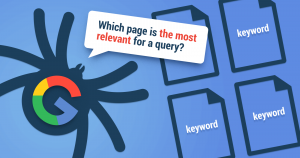
It is a very common misconception that the more pages you are targeting a keyword, the better you would be ranking for that keyword. However, this is not true. In fact, targeting a specific term across multiple pages almost has the opposite effect and thus you would be doing more harm than good for your SEO. When you have multiple pages ranking for the same keyword, you are actually competing with yourself. Thus, each page has a lower conversion rate than one consolidated page and this is what is known as Keyword Cannibalization.
What is Keyword Cannibalization?
Keyword Cannibalization means you are cannibalizing your own results. It means you are splitting links, content, and conversions between two pages that should otherwise be one. In this way, you are not helping Google to find the depth of your knowledge, instead, you are asking Google to weight your pages against each other and choose out the ones which you think suits the matching keywords.
For example, suppose if your website sells jackets, and “Jackets” is the only keyword you are targeting, you are telling Google that every page is about jackets regardless of whether they are sports jackets, running jacket, etc.
Negative effects Keyword Cannibalization can have on your SEO
Many people who are suffering from Keyword Cannibalization are not even aware of what is wrong with them. At times, they might be happy that one page is ranking in the fifth and sixth slot for their targeted keyword, without realizing that one dedicated page would certainly rank higher and convert better.
- Diminishing the Value of your Page
Instead of having one highly authoritative page, you are splitting your CTR to multiple moderately relevant pages. You have turned your pages into competitors and fighting with your own self.
- Google May Devalue the more relevant Page
Keywords are one of the main ways that help Google understand what the particular website page is all about. Google tries to understand which page is the best fit.
- Sign of Poor Page Quality
At times, multiple pages are targeting the same keyword and tell your users that your content is probably stretched thin. It also signals Google that your content may or may not match your keywords.
- Conversion rate will suffer
Without any doubt, one of your page will convert better than the rest. Instead of directing new visitors to that page and making it the most authoritative, you are losing potential leads.
How to identify Keyword Cannibalization
Once the problem has been identified, fixing keyword Cannibalization is easy. Create a spreadsheet that lists all of your site’s important URL and the keywords associated. In addition, you can also use a keyword mapping tool to get better results.
Moreover, keyword cannibalization can also occur if the meta information in your title tags seem to target the same keyword. With the help of a rank tracking tool, you can also check if the content and keywords are mistakenly applied to the wrong page.
How to Fix Keyword Cannibalization
- Restructure your website
The simplest way is to take your most authoritative page and turn it into a landing page that link to other unique variations.
- Create New Landing Pages
You might be lacking in a landing page that consolidates all of your product pages in one place. In this case, you would benefit from creating a unique landing page to serve as your authoritative source page and link to all of your other pages.
- Consolidate your content
If your pages are not unique to warrant having multiple pages targeting the same keyword, consider combining them into one page. This is a great chance to take two underperforming pages and turn them into a more authoritative source.
- Find New Keywords
If you are already blessed with highly diverse, content-rich pages, and the only thing your website is suffering from is a poorly planned keyword strategy, then all you need is to find new keywords. Make sure you use proper keywords and your keywords describe your page’s content accurately.
Conclusion
Keyword cannibalization is more prevalent today than the earlier times. Its victims are usually webmasters who recognize the importance of SEO for their business. With the right tools and a positive attitude, you can give your SEO a well-deserved boost.










